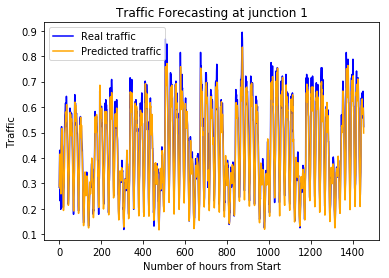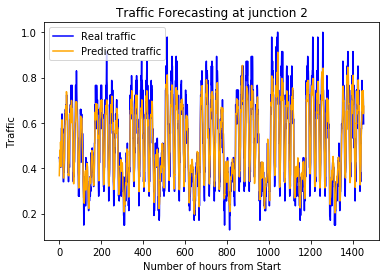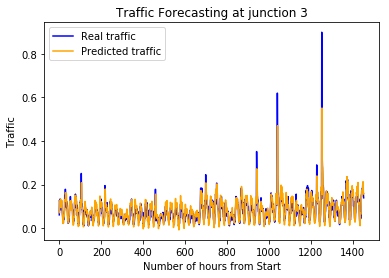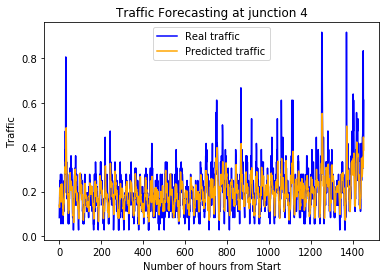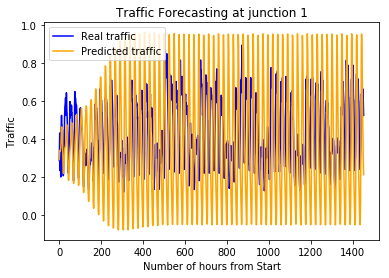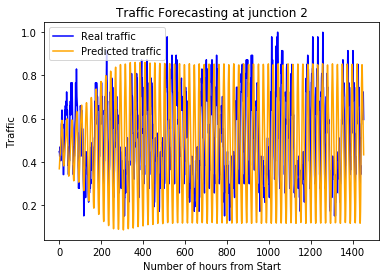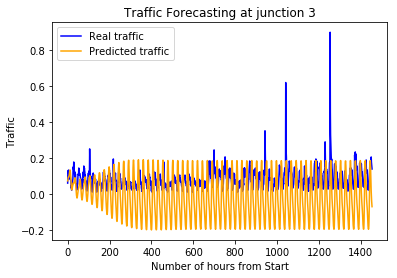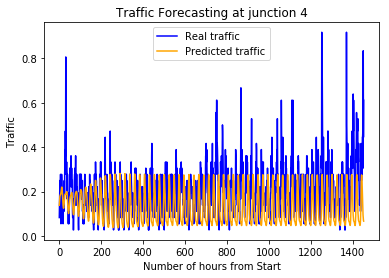Task: To predict traffic patterns in each of these four junctions.
Data: The sensors on each of these junctions were collecting data at different times, hence you will see traffic data from different time periods. To add to the complexity, some of the junctions have provided limited or sparse data requiring thoughtfulness when creating future projections. Depending upon the historical data of 20 months, the government is looking to you to deliver accurate traffic projections for the coming four months. Your algorithm will become the foundation of a larger transformation to make your city smart and intelligent.
The evaluation metric for the competition is RMSE. Public-Private split for the competition is 25:75.
Exploratory Data Analysis (EDA)
See here
We have 48120 point of training data (data each hour from 2015-11-01 to 2017-06-30 for 4 junctions) And 11808 points to predict
Approach
Instead of using time-series classics ARMA (auto-regressive moving average) and ARIMA (autoregressive integrated moving average) models or the Kaggle competition classic XGBoost, I choose to try my hand at neural networks.
Given the time constraint, I had to use Keras for quicker prototyping and more documentations even though my preferred framework is PyTorch.
The direct consequence is unoptimized seq2seq as I couldn't share weights between RNNs in Keras at the time (Nov2017).
Architecture
I used a multi-attention Recurrent Neural Network defined as below to capture lag features.
def attention_n_days_ago(inputs, days_ago):
# inputs.shape = (batch_size, time_steps, input_dim)
time_steps = days_ago * 24
suffix = str(days_ago) +'_days'
# We compute the attention over the seq_len
a = Permute((2, 1),
name='Attn_Permute1_' + suffix)(inputs)
a = Dense(time_steps,
activation='softmax',
name='Attn_DenseClf_' + suffix)(a)
# Now we convolute so that it averages over the whole time window
feats_depth = int(inputs.shape[2])
avg = Lambda(lambda x: K.expand_dims(x, axis = 1),
name='Attn_Unsqueeze_' + suffix)(inputs)
avg = SeparableConv2D(feats_depth, (1,1),
name='Attn_DepthConv_' + suffix)(avg)
avg = Lambda(lambda x: K.squeeze(x, 1),
name='Attn_Squeeze_'+ str(days_ago) + '_days')(avg)
a_probs = Permute((2, 1),
name='Attn_Permute1_' + suffix)(avg)
# out = Multiply(name='Attn_mul_'+ suffix)([inputs, a_probs])
out = Concatenate(name='Attn_cat_'+ suffix)([inputs, a_probs])
return out
def Net(num_feats, seq_len, num_hidden, num_outputs):
x = Input(shape=(seq_len, num_feats))
# Encoder RNNs
enc = CuDNNGRU(seq_len,
return_sequences=True,
stateful = False,
name = 'Encoder_RNN')(x)
# Attention decoders (lag features)
attention_0d = attention_n_days_ago(enc, 0)
attention_1d = attention_n_days_ago(enc, 1)
attention_2d = attention_n_days_ago(enc, 2)
attention_4d = attention_n_days_ago(enc, 4)
attention_1w = attention_n_days_ago(enc, 7)
attention_2w = attention_n_days_ago(enc, 14)
attention_1m = attention_n_days_ago(enc, 30)
attention_2m = attention_n_days_ago(enc, 60)
attention_1q = attention_n_days_ago(enc, 92)
attention_6m = attention_n_days_ago(enc, 184)
attention_3q = attention_n_days_ago(enc, 276)
attention_1y = attention_n_days_ago(enc, 365)
att = Concatenate(name='attns_cat', axis = 1)([attention_0d,
attention_1d,
attention_2d,
attention_4d,
attention_1w,
attention_2w,
attention_1m,
attention_2m,
attention_1q,
attention_6m,
attention_3q,
attention_1y])
# How to merge? concat, mul, add, use Dense Layer or convolution ?
att = Dense(seq_len, activation=None, name='Dense_merge_attns')(att)
# att = Lambda(lambda x: softmax(x, axis = 1),
# name='Dense_merge_3D_softmax')(att) # Flatten along the concat axis
# Decoder RNN
dec = CuDNNGRU(num_hidden,
return_sequences=False,
stateful = False,
name='Decoder_RNN')(att)
# Regressor
# Note that Dense is automatically TimeDistributed in Keras 2
out = Dense(num_outputs, activation=None,
name = 'Classifier')(dec) # no activation for regression
model = Model(inputs=x, outputs=out)
model.compile(loss= root_mean_squared_error, optimizer = optim)
return modelImportant note: make sure to use CUDNNGru and CUDNNLSTM because the default GRU and LSTM are implemented by Google in Tensorflow while the CuDNN were by Nvidia. Google version is slow
Results
Teacher forcing by predicting 48 hours (bassed on real historical values):
Predicting the whole 3 months based on previous predictions:
Note: the optimizer chosen has a big influence on the last part,
using RMSprop instead of Adam would give me some response during the first week and then 0 traffic the whole time left.
I then ran out of time to debug the issue of my model predicting a sinusoid.
Future work
I probably should reimplement that in a dynamic framework like PyTorch to share the state between the RNN. Furthermore ARMA/ARIMA capture the general trend but as shown by the 48 hours prediction, my model can capture fast change quite well. So stacking both + an xgboost model should improve the results a lot.
An alternative approach would be to use WaveNet and pure CNNs instead of RNNs

